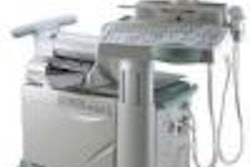CHICAGO - Ultrasound-guided percutaneous needle therapy is an effective treatment option for sports-related joint injuries that don’t respond to conservative treatments, according to Dr. Levon Nazarian, professor of radiology at the Jefferson Medical College of Thomas Jefferson University, Philadelphia. Nazarian presented a study on the topic at this week's RSNA meeting.
For years, sports medicine specialists have been injecting injured elbows and knees with either anesthetics or corticosteroids to treat minor tears, Nazarian said. "But we are combining ultrasound with needle therapy so that the needle is carefully guided to the point of injury," he said. Sixty-five percent of patients treated with the US-guided technique had pain-free restoration of function in 2 to 12 weeks, he said.
Moreover, while standard "needle therapy" either draws fluid out of a joint or injects something into the injured joint, the ultrasound-guided needle therapy allows the sports medicine specialist to use to needle as a very tiny surgical instrument "to either break up scars or poke holes in an injured ligament so that bleeding occurs. The blood cells carry precursors to collagen, which eventually develops into collagen to replace the damaged tissue," Nazarian said.
All patients are initially injected with an anesthetic into the injured area. "This serves as a useful test to determine if the pathology visualized on ultrasound is the actual cause of the patient’s pain. If the pain disappears after anesthesia, we know we are on the right track," Nazarian said. But once the anesthesia is injected, the patient may be treated with just "needle surgery" or may receive corticosteroid injections or additional anesthesia.
"The advantage to this procedure is that it is so minimally invasive that restoration of function is very rapid, much more so than even arthroscopic surgery," Nazarian said.
Also, the technique offers a surgical option for patients who have "tears or abnormalities that are so small that they cannot be fixed by surgeons and yet they are not responding to conservative treatment of rest, ice, and support," he added.
Thus far, Nazarian has accumulated more than 300 patients in his series, but he presented data on 273 patients who ranged in age from 13 to 82. The mean age was 39.8. About half of the patients were men, and all of the patients had failed conservative management.
Patients were treated from December 1999 through January 2002, and all received US-guided needle therapy using a phased-array linear transducer (7.5 MHz to 13 MHz).
Two-hundred forty-six patients underwent US-guided corticosteroid injection combined with needle debridement. The range of pathology treated included tendonopathy, tendon tear, muscle tear, bursitis, tenosynovitis, ligamentous injury, and plantar fasciitis. The most common anatomic areas were the common extensor tendon at the lateral elbow and the patellar tendon. The remaining patients were treated with needle debridement without corticosteroid injection.
The average procedure time was one hour. Patients were instructed to perform only light stretching for the first 2 weeks, strengthening exercises from weeks 2-6, and then a gradual return to higher-level activities.
While 65% of patients reported symptom relief in 2 to 12 weeks, Nazarian said 35% were unchanged. "But these patients still had all options open to them. Since we didn’t treat with traditional surgery, no bridges were burned," he said. Moreover, even patients who didn’t improve did not have worsening of symptoms. There were no complications from bleeding, infections, or procedure.
Dr. Michael Sullivan, associate chairman in the department of radiology at Ochsner Clinic Foundation in New Orleans, said using ultrasound to guide needle therapy is a major advance. "For years, people have been injecting joints blindly: if it hurts here, inject here," he said. "That can be successful, but it can also cause more harm than good. This is really a logical way to improve that approach." Sullivan was not involved in Nazarian’s study.
Asked if the ultrasound-guided approach will be used to treat professional athletes, Nazarian said "we were at spring training with the Phillies (baseball team) last year and I can tell you that this was very effective for a minor league pitcher. You know if you operate on an athlete, that often means missing all or most of a season. Using this approach, he was back in the line-up in a short time. I don’t know if he will ever make the major leagues, but I think this procedure helped him have a better chance."
Nazarian said that he also used the US-guided technique to treat an English soccer player who was frequently benched by injuries, but after treatment the man went on "to be named an alternate to the Britain’s World Cup team."
By Peggy Peck
AuntMinnie.com contributing writer
December 5, 2002
Copyright © 2002 AuntMinnie.com



















